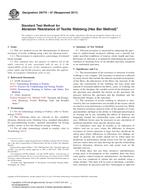Potřebujeme váš souhlas k využití jednotlivých dat, aby se vám mimo jiné mohly ukazovat informace týkající se vašich zájmů. Souhlas udělíte kliknutím na tlačítko „OK“.
ASTM D6770-07(2011)
Standard Test Method for Abrasion Resistance of Textile Webbing (Hex Bar Method)
Automaticky přeložený název:
Standardní zkušební metoda pro odolnost proti oděru textilní popruhy (Hex Bar Method)
NORMA vydána dne 1.5.2011
Informace o normě:
Označení normy: ASTM D6770-07(2011)
Poznámka: NEPLATNÁ
Datum vydání normy: 1.5.2011
Kód zboží: NS-36469
Počet stran: 9
Přibližná hmotnost: 27 g (0.06 liber)
Země: Americká technická norma
Kategorie: Technické normy ASTM
Anotace textu normy ASTM D6770-07(2011) :
Keywords:
hex-bar abrasion resistance, webbing, Abrasion resistance--textile fabrics/fibers, Breaking strength/tenacity--textile fabrics/fibers, Hex-bar abrasion resistance, Retained breaking strength, Textile webbing, ICS Number Code 59.080.30 (Textile fabrics)
Doplňující informace
| Significance and Use | ||||||||
|
The measurement of the resistance to abrasion of textile webbing is very complex. The resistance to abrasion is affected by many factors that include the inherent mechanical properties of the fibers; the dimensions of the fibers; the structure of the yarns; the construction of the webbing; the type, kind, and amount of treatment added to the fibers, yarns, or webbing; the nature of the abradant; the variable action of the abradant over the specimen area abraded; the tension on the specimen; the pressure between the specimen and the abradant; and the dimensional changes in the specimen. The resistance of textile webbing to abrasion as measured by this test method does not include all the factors which account for wear performance or durability in actual use. While the abrasion resistance stated in terms of the number of cycles and durability (defined as the ability to withstand deterioration or wearing out in use, including the effects of abrasion) are frequently related, the relationship varies with different end uses. Different factors may be necessary in any calculation of predicted durability from specific abrasion data. Laboratory tests may be reliable as an indication of relative end use in cases where the difference in abrasion resistance of various materials is large, but they should not be relied upon where differences in laboratory test findings are small. In general, the results should not be relied upon for prediction of performance during actual wear life for specific end uses unless there are data showing the specific relationship between laboratory abrasion tests and actual wear in the intended end use. While there has not been extensive interlaboratory testing prior to development of this standard, there has been some quality control testing by manufacturers. An intralaboratory test was conducted to initiate this test method, using a single product. This data will be used to determine a preliminary statement on precision and bias. Subsequent to approval of this standard, a formalized interlaboratory procedure will be initiated under the direction of a professional statistician and will produce a research report. Samples used in this controlled test will be representative of end use applications. These general observations apply to most webbings that are used in automotive, aerospace, industrial, and military applications. This test method can be used for acceptance testing of commercial shipments but comparisons should be made with caution because estimates of between-laboratory precision are incomplete. If there are differences of practical significance between reported test results for two laboratories (or more), comparative tests should be performed to determine if there is a statistical bias between them, using competent statistical assistance. As a minimum, use samples for such comparative tests that are as homogenous as possible, drawn from the same lot of material as the samples that resulted in disparate results during initial testing, and randomly assigned in equal numbers to each laboratory. The test results from the laboratories involved should be compared using a statistical test for unpaired data, at a probability level chosen prior to the testing series. If bias is found, either its cause must be found and corrected, or future test results must be adjusted in consideration of the known bias. |
||||||||
| 1. Scope | ||||||||
|
1.1 This test method covers the determination of abrasion resistance of textile webbing using a hex bar abrasion tester. 1.1.1 The resistance is expressed as a percentage of retained break strength. 1.2 This standard does not purport to address all of the safety concerns, if any, associated with its use. It is the responsibility of the user of this standard to establish appropriate safety and health practices and determine the applicability of regulatory limitations prior to use. |
||||||||
| 2. Referenced Documents | ||||||||
|
Doporučujeme:
Aktualizace technických norem
Chcete mít jistotu, že používáte pouze platné technické normy?
Nabízíme Vám řešení, které Vám zajistí měsíční přehled o aktuálnosti norem, které používáte.
Chcete vědět více informací? Podívejte se na tuto stránku.




 Cookies
Cookies
